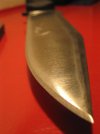- Joined
- Jun 8, 2005
- Messages
- 4,761
The coating on my Offset has always annoyed me. I hate how black coatings look, but this one scratches unbelievably easily, and I'm getting a lot of spots of rust even through the stupid coating.
So how do I get rid of the stuff? Keep in mind that this has a stud lock, which may have to be taken into account.
Also, what would the finish be like underneath the coating?
So how do I get rid of the stuff? Keep in mind that this has a stud lock, which may have to be taken into account.
Also, what would the finish be like underneath the coating?





